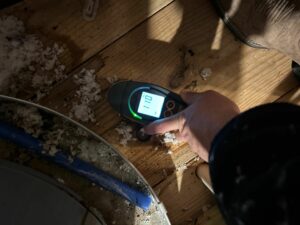Blogs
Why Timely Smoke and Soot Removal Matters After a Fire

In the aftermath of a fire, the urgency of timely smoke and soot removal cannot be overstated. Beyond the visible destruction caused by flames, lingering smoke and soot pose severe threats to both property and human health. These minute particles have the potential to infiltrate every nook and cranny, permeating surfaces and air. Swift removal is crucial as these contaminants can trigger respiratory issues and cause long-term damage to structures. This article by Instensa Dry explores the pervasive nature of smoke and soot underscores the importance of immediate and thorough cleaning, preventing secondary harm and ensuring a safer, healthier environment for recovery and restoration efforts.

“The Hidden Threat: Lingering Smoke and Soot”
In the aftermath of a fire, the often-underestimated menace of lingering smoke and soot emerges as a pervasive and hidden threat. Beyond the visible devastation caused by flames, these microscopic particles infiltrate spaces, settling on surfaces and permeating the air. The insidious nature of smoke and soot lies in their ability to silently corrode structures and pose significant health risks. With the potential to trigger respiratory issues, immediate attention to their removal becomes paramount. This article delves into the concealed dangers of smoke and soot, emphasizing the critical need for timely and comprehensive cleaning to mitigate both visible and concealed consequences.
“Beyond the Flames: Understanding Secondary Damage”
While the immediate impact of a fire is evident in the charred remnants, an often-underestimated concern lies in the realm of secondary damage. Beyond the visible destruction caused by flames, a cascade of indirect consequences can unfold. Smoke and soot, with their insidious ability to infiltrate every corner, pose a persistent threat. Structural weakening, corrosive residue, and compromised air quality constitute the less apparent aftermath. This article explores the nuanced landscape of secondary damage after a fire, shedding light on the hidden repercussions that demand attention. Understanding these complexities is crucial for comprehensive recovery efforts and effective restoration in the wake of a fire’s aftermath.
“Respiratory Risks: Health Implications of Smoke Exposure”
In the aftermath of a fire, the pervasive threat to human health extends beyond visible damage, particularly through the inhalation of smoke. Microscopic particles released during combustion infiltrate the respiratory system, presenting severe health implications. Exposure to these airborne contaminants can trigger respiratory distress, exacerbate existing conditions, and lead to long-term health issues. This article delves into the intricacies of respiratory risks associated with smoke exposure, emphasizing the urgent need for mitigation strategies. Understanding the health consequences is paramount for both immediate medical considerations and long-term well-being in the aftermath of a fire.
“Swift Action Required: Importance of Timely Removal”
In the aftermath of a fire, the urgency of prompt and decisive action cannot be overstated, particularly in the context of timely smoke and soot removal. Lingering in the aftermath, these invisible hazards pose serious threats to both property and human health. Swift removal is essential to prevent the pervasive infiltration of these particles into every nook and cranny, safeguarding structures and inhabitants alike. This article underscores the critical importance of immediate and comprehensive cleanup efforts, emphasizing how swift action mitigates the risk of secondary damage, preserves property integrity, and ensures a safer, healthier environment for recovery and restoration endeavors.
“Permeating Every Surface: The Infiltration of Smoke and Soot”
In the aftermath of a fire, the insidious reach of smoke and soot becomes a silent, pervasive force, permeating every surface within its grasp. These microscopic particles, generated during combustion, possess an uncanny ability to infiltrate spaces both conspicuous and concealed. From walls to furniture, and even within the intricate crevices of a structure, smoke and soot leave no space untouched. This article delves into the challenges posed by the infiltration of these contaminants, emphasizing the comprehensive measures required for their removal. Understanding the depth of this penetration is crucial for effective cleanup and restoration, preventing long-term structural deterioration and health hazards.
“Property Preservation: Preventing Long-Term Structural Damage”
In the aftermath of a fire, the immediate focus on extinguishing flames often overshadows the latent threat of long-term structural damage. Beyond the visible destruction, the residue left by smoke and soot poses a persistent peril. Neglecting timely and thorough cleanup can lead to corrosive consequences, compromising the integrity of buildings over time. This article underscores the critical importance of property preservation through proactive measures. Examining the potential hazards that linger post-fire, it emphasizes the necessity of prompt cleanup to safeguard against structural deterioration. Understanding and addressing these risks promptly is paramount for the sustained resilience and durability of affected properties.
“The Aftermath Challenge: Navigating Cleanup and Restoration”
The aftermath of a fire presents a multifaceted challenge, requiring a delicate balance between comprehensive cleanup and meticulous restoration efforts. Beyond the visible devastation, the residue of smoke and soot demands strategic navigation. This article delves into the complexities of post-fire cleanup, addressing the intricate task of restoring normalcy. From assessing structural damage to mitigating health risks, effective strategies for debris removal and restoration must be employed. Navigating this multifaceted challenge demands a systematic approach, combining expertise and technology to ensure a thorough recovery. Understanding the nuances of cleanup and restoration is pivotal for a successful transition from devastation to renewal.
“Air Quality Matters: Protecting Inhabitants from Harmful Particles”
In the aftermath of a fire, the significance of air quality cannot be overstated, as the lingering threat of harmful particles, such as smoke and soot, poses imminent dangers to inhabitants. This article explores the critical importance of maintaining air quality post-fire, emphasizing the potential health risks associated with prolonged exposure to airborne contaminants. From respiratory issues to more severe health complications, the impact on well-being underscores the urgent need for effective mitigation strategies. Focusing on protecting occupants from the invisible aftermath, this piece underscores the role of comprehensive cleanup and ventilation systems in safeguarding the immediate and long-term health of those affected.
Residue Resilience: Dealing with Stubborn Soot Deposits
Amidst the aftermath of a fire, the tenacious challenge of stubborn soot deposits emerges as a formidable adversary. This article delves into the resilience of soot, emphasizing the persistent nature of its residue on various surfaces. From walls to belongings, these stubborn deposits demand specialized attention and cleaning techniques. Understanding the intricacies of soot removal is essential for preventing long-term discoloration, corrosion, and odors. Highlighting effective strategies, this piece navigates the nuanced task of dealing with resilient soot, underscoring the importance of thorough cleanup to restore not just the appearance but the integrity of spaces affected by its enduring presence.
Professional Help
When faced with the aftermath of a fire, seeking professional assistance becomes an imperative step towards comprehensive recovery. Trained experts bring a wealth of knowledge and experience, equipped to navigate the complexities of post-fire challenges. From assessing structural integrity to employing advanced cleaning techniques, their expertise ensures a thorough cleanup and restoration process. Professional help extends beyond visible damage, addressing hidden threats like smoke and soot infiltration. Timely intervention not only mitigates health risks but also safeguards against long-term structural issues. This article underscores the invaluable role of professional help, emphasizing the efficiency and effectiveness they bring to the challenging task of post-fire recovery.
Conclusion
In conclusion, the aftermath of a fire demands a swift and comprehensive response to mitigate the diverse threats posed by smoke and soot. From immediate health risks to potential long-term structural damage, the intricacies of cleanup and restoration require careful consideration. Recognizing the importance of timely action, professional assistance, and strategic measures is pivotal in safeguarding both property and human well-being. The hidden dangers of lingering particles emphasize the necessity of thorough cleanup to restore spaces to a safe and habitable state. As communities and individuals navigate the challenging aftermath, a proactive and informed approach to recovery becomes essential for a resilient and successful restoration process.

